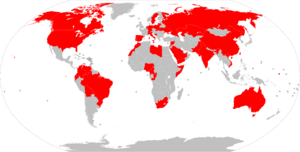Primate city facts for kids
A primate city is the largest city in a country, state, or region. It's much bigger and more important than any other city around it. Imagine one giant city with many smaller towns, but no medium-sized cities in between – that's often what a primate city looks like.
The idea of a primate city was first explained by a geographer named Mark Jefferson in 1939. He said a primate city is usually at least twice as big as the next largest city. Besides its size, a primate city is also super important for a country's money, government, culture, and schools. Many people from other parts of the country also move to the primate city.
In geography, when one city grows much larger and more powerful than others, it's called urban primacy or urban macrocephaly. This often happens because the main city gets most of the country's development, sometimes leaving other areas behind.
Contents
How We Measure Primate Cities
We can measure how "primate" a city is by looking at how many people live there compared to the country's total population. We also compare its population to the second-largest city. This is called relative primacy. For example, if a city has 10 million people and the next biggest has 2 million, its relative primacy is 5.
Why Primate Cities Are Important
People debate if a primate city helps or hurts a country. Some think it shows that one part of the country is growing fast (the city), while other parts are falling behind. The city often relies on these other areas for workers and resources. However, how cities are structured doesn't always depend on how rich a country is.
Many primate cities keep growing and attracting more people. This can happen because fewer jobs are available in rural areas due to machines doing more work. At the same time, more jobs for educated people (like in government, money, media, and education) are found in these big cities. This is because power and wealth are often found there.
Examples of Primate Cities
Many important cities around the world are also primate cities. For example, Istanbul in Turkey is a primate city because it has a huge influence on Turkey's economy, government, culture, and education. Other well-known primate cities include Mexico City, Paris, Cairo, Jakarta, and Seoul.
However, not all countries have a primate city. The United States doesn't have one at a national level. This is because its cities are more spread out. For instance, New York City is the largest, but Los Angeles isn't far behind in population or economic power.
Even if a country doesn't have a national primate city, its states or provinces might. For example, New York City is the primate city for New York State. It's 32 times bigger than Buffalo, the state's second-largest city! Similarly, Anchorage is the primate city for Alaska, with about 40% of the state's population living there.
China doesn't have a national primate city, but many of its provincial capitals are much larger than other cities in their provinces. For example, Zhengzhou in Henan, Wuhan in Hubei, and Chengdu in Sichuan are all much bigger than their provinces' second-largest cities. India also doesn't have a national primate city, but many Indian states, like Karnataka (with Bangalore) and West Bengal (with Kolkata), do.
Bangkok, the capital of Thailand, is sometimes called "the most primate city on Earth." In 2000, it was 40 times larger than the next biggest city! Even today, it's nearly nine times larger than Chiang Mai, Thailand's current second-largest city. When primate cities are also national capitals, they can be easy targets for protests or military takeovers because most of the country's power and people are in one place.
Moscow, the capital of Russia, is another example. Its metropolitan area is almost four times the size of Saint Petersburg, the next largest city. Moscow is clearly the main cultural and political center of Russia.
A primate city doesn't always have to be the capital city. Sometimes, governments move the capital to a new city to try and balance growth. For example, in Tanzania, Dar es Salaam is still the primate city even though the capital moved to Dodoma in 1996. The same happened in New Zealand, where Auckland is still much larger and more important than the capital, Wellington.
Primate Cities Around the World (Examples)
Many countries across different continents have primate cities:
- Africa: Cairo in Egypt, Lagos in Nigeria, and Kinshasa in the Democratic Republic of the Congo are huge cities that dominate their countries.
- Asia: Besides the examples already mentioned like Istanbul and Jakarta, Manila in the Philippines and Kuala Lumpur in Malaysia are also strong primate cities.
- Europe: Paris in France and London in the United Kingdom are classic examples of primate cities, being much larger and more influential than any other city in their countries. Athens in Greece and Budapest in Hungary also fit this pattern.
- North and Central America: Mexico City is a prime example. In the Caribbean, cities like Havana in Cuba and Santo Domingo in the Dominican Republic are also primate cities.
- Oceania: While Australia doesn't have a national primate city, its state capitals like Sydney and Melbourne act as primate cities for their respective states. Auckland is the primate city for New Zealand.
- South America: Buenos Aires in Argentina, Lima in Peru, and Santiago in Chile are all much larger and more important than other cities in their countries.
See also
 In Spanish: Ciudad principal para niños
In Spanish: Ciudad principal para niños



